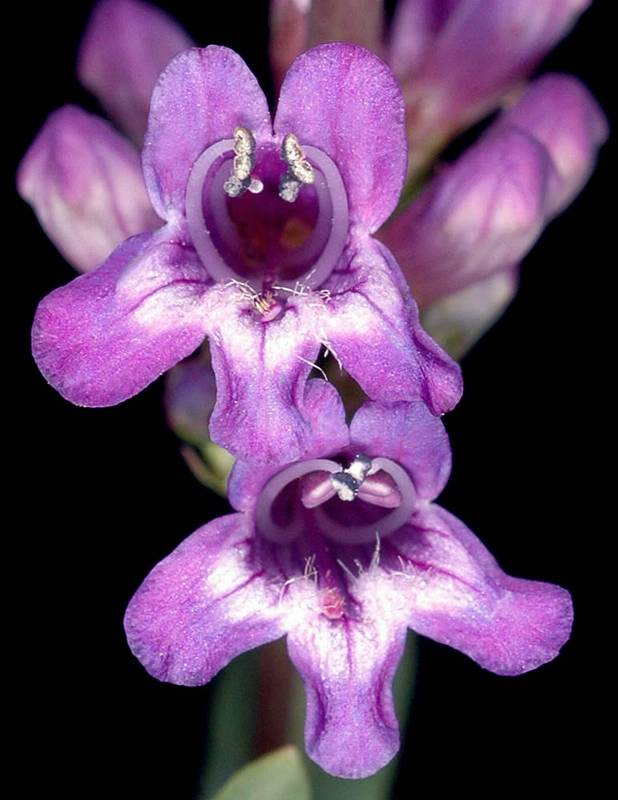|
glaucous beardtongue
|
Barrett's beardtongue
|
| Tufted perennial from a woody rhizome, the slender stems 2-7 dm. tall, glabrous and glaucous throughout. |
Perennial, the lower part shrubby and branched, the stems 2-4 dm. tall; herbage and inflorescence glabrous and glaucous. |
Leaves opposite, entire, the basal ones petiolate, oblanceolate, forming well-developed rosettes, up to 15 cm. long and 2 cm. wide; cauline leaves few, well-developed, sessile, not over 10 cm. long and 2 cm. wide. |
Leaves opposite, firm, irregularly serrulate or entire, the larger ones, up to 8 cm. long and 2.5 cm. wide, on sterile shoots borne toward the base of the main stem; cauline leaves broad, sessile, and clasping, 1.5-3.5 cm. long and 0.8-2 cm. wide |
Inflorescence of 1-several dense verticillasters, the flowers spreading at right angles to the stem; calyx 3.5-5 mm. long, the 5 segments broadly scarious-margined, abruptly contracted to a narrow, pointed tip; corolla blue-purple, 11-15 mm. long, bilabiate, the tube expanded, 3-5 mm. wide at the mouth; raised portion of the lower petal bearded; staminode usually bearded at the expanded tip; pollen sacs glabrous, ovate, 0.6-1.0 mm. long, not quite opening to the tip. |
Inflorescence essentially a raceme, the axillary peduncles simple and single-flowered or sometimes branched and 2-flowered; calyx 5-7 mm. long, the 5 segments thin, ovate; corolla bilabiate, lilac or rose-purple, 33-38 mm. long, 1 cm. wide at the mouth, glabrous outside, long-hairy near the base of the lower lip within; anthers densely long-woolly, pollen sacs wholly dehiscent, becoming opposite |
Capsule 5-6 mm. long |
Capsule narrow, up to 1 cm. long. |
|
|
|
|
| June-September |
April-May |
| Dry, sandy, open or sparsely wooded slopes at moderate elevations to subalpine meadows. |
Woodland openings and rocky slopes at low elevations. |
Occurring in the Cascades Range in Washington from Mt Adams south; Washington to central Oregon.
|
Occurring in the east end of the Columbia River Gorge in Washington; south-central Washington to adjacent north-central Oregon.
|
| Native |
Native |
| Not of concern |
Threatened in Washington (WANHP) |
P. acuminatus, P. attenuatus, P. barrettiae, P. cardwellii, P. cinereus, P. confertus, P. davidsonii, P. deustus, P. ellipticus, P. eriantherus, P. fruticosus, P. gairdneri, P. glandulosus, P. hesperius, P. lyallii, P. ovatus, P. palmeri, P. pennellianus, P. procerus, P. pruinosus, P. richardsonii, P. rupicola, P. rydbergii, P. serrulatus, P. speciosus, P. subserratus, P. triphyllus, P. venustus, P. washingtonensis, P. wilcoxii |
P. acuminatus, P. attenuatus, P. cardwellii, P. cinereus, P. confertus, P. davidsonii, P. deustus, P. ellipticus, P. eriantherus, P. euglaucus, P. fruticosus, P. gairdneri, P. glandulosus, P. hesperius, P. lyallii, P. ovatus, P. palmeri, P. pennellianus, P. procerus, P. pruinosus, P. richardsonii, P. rupicola, P. rydbergii, P. serrulatus, P. speciosus, P. subserratus, P. triphyllus, P. venustus, P. washingtonensis, P. wilcoxii |
| |



